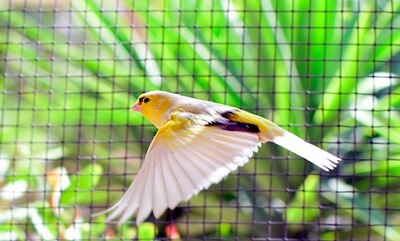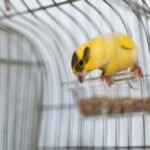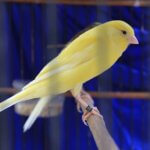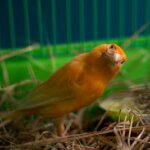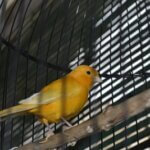Canaries don’t need to be kept in pairs. However, they’re still intelligent animals that need mental stimulation, so they can grow bored and destructive when kept in small cages for long periods.
Some owners hesitate to provide free-flight time for canaries, as they feel this puts their pets at risk. While it’s true that dangers exist outside the cage, there are many ways to safeguard a room.
Let’s examine the pros and cons of letting a canary out of its cage.
Should I Let My Canary Out of Its Cage?
Unless a canary lives in an aviary, it’s important to let them out to free-roam occasionally. That’s because wild canaries have free access to the sky and miles of territory to explore.
Even if wild canaries stay near a specific area or nest, they can still stretch their wings, explore, and fly for hundreds of yards at the minimum. According to Animals, this isn’t possible within a cage.
Keeping a canary in a small or constrictive cage with no free-roaming time can damage its physical health. It’ll lack space to exercise and stay active since jumping from one perch to another is limiting.
Worst still, it can affect the canary psychologically, leading to boredom, lethargy, and depression.
Unfortunately, letting a canary fly in your home isn’t always safe. Whether you allow free-flight sessions will depend on the following factors:
Available Time
All free-flight time must be supervised. Accidents can happen even if your canary is in an otherwise safe room, and you need to be present to monitor the bird.
It may run into a window, hit a fan, or escape as you enter or exit the room. So, it’s important to section off time to supervise your canary as it exercises.
Additionally, if you only let your canary out of its cage for a few minutes, it won’t get the amount of exercise and exploration time it desires. After the session, it’ll refuse and even resist returning to its cage.
If possible, set aside at least two hours for the canary to fully experience the freedom of free flight. This will give it time to stretch its wings, explore interesting spots, and adjust to the open space.
Safety
If you don’t have a safe space in your home where the canary can fly and play, avoid letting it out. The downside of being isolated to the cage won’t outweigh the risk.
For example, you may have an apartment that keeps you from isolating your canary to a specific room. It’ll have access to your kitchen, which could expose it to fumes from cookware.
If you have another pet that you can’t safely isolate to another room (even the bathroom in smaller homes), the canary will be in danger from a cat or dog.
If you share your home with roommates and only have private access to your bedroom, it’s possible this space isn’t secure either. You may have hanging decorations, sharp objects, or other items filling the space, which canaries could run into or get lost in.
The canary may get startled when exposed to these noises, movements, and sights, even in a safe home surrounded by noise and activity (such as outside road traffic or passersby).
Safely tucked into its cage, the canary may be able to ignore it, but the bird could get spooked when it lands near the window and is startled by a car roaring past.
In these situations, keeping your canary in its cage is best until you can better safeguard the area. Some adjustments will be minor, while others will be more severe.
This may include rearranging your bedroom to be safer for a canary, asking a friend to take your other pet somewhere else, or removing and covering any threats in your kitchen.
Number of Canaries
If you only have a single canary, it’s easier to monitor it during flight time and ensure its safety. Beyond that, it’ll most likely get bored of flying and exploring the room in less than an hour.
However, if you have a pair, they’ll take more time to explore the environment. They’ll also be harder to watch, as they may split up to check different areas.
Additionally, if you have multiple birds, it may be harder to return each of them to the cage.

Pros And Cons Of Cage-Free Time For Canaries
The benefits of letting your canary fly outside its cage shouldn’t be understated.
As mentioned, it’s natural for canaries to explore wider spaces, and replicating this in your home will improve their physical and mental health. The advantages include the following:
- Preventing boredom: Canaries require mental stimulation. Remaining in the same restrictive cage all day can lead to boredom and poor behavior. Flight time provides a new, interesting environment.
- Improved physicality: Canaries that stretch their wings, fly greater distances and navigate through new areas exercise their muscles, hearts, and circulation.
- Bonding time: Supervising your canary, singing to it while it plays, and showing off new areas are great ways to bond with the canary.
Of course, there are risks to letting your canary out of its cage. Factors that might lead you to buy a larger cage instead or implement safeguards are your home include:
- Deadly insects: Canaries might find insects around your home, either dead or alive, and eat them without you noticing. Some will be toxic, either by nature or through exposure to pesticides. According to the International Journal for Parasitology, mosquitoes can bite your canary and transmit malaria-causing parasites.
- Drowning: A bowl soaking in the kitchen sink, access to a toilet, or a pet’s water dish can lead to drowning. The canary might try to bathe in it and misjudge the depth.
- Other pets: Cats, dogs, ferrets, and reptiles can threaten your canary.
- Risk of escape: A window you forgot to close, a gap in a window or door screen, or a person coming home unexpectedly and opening the door can all lead to your canary escaping.
Not letting your canary out of its cage will make it safe, but this can also harm it physically and mentally. A happy canary means little if it gets sick or escapes, making it important to use the right precautions when letting your canary free-fly.
How to Safely Let Your Canary Out of Its Cage
These steps will mitigate the risks while still allowing your canary to enjoy time outside of its cage:
Remove Dangers
It’s best to let your canary out in a single room rather than in the greater home. This allows you to perform a safety check more effectively, and there will be fewer surprises.
Ensure you close all windows, doors, and exit points, and turn off all fans and electronics.
You should remove sharp objects, water bowls, close toilet lids, and vacuum the floor. This will ensure the canary is unlikely to find, eat, drown, or get entangled in something.
If you have pets, remove them from the area. This may include barring them from the room or locking them in the bathroom for a time, so your canary wouldn’t encounter them.
You can also pull the window shades, so the canary doesn’t run into the window or get startled.
More Comfortable
During the first couple of sessions, speak to your canary calmly before you let it out. Open the cage door and stay nearby, singing or socializing with the canary to let it know this is a happy, safe time.
If your canary is reluctant to approach, place it on top of the cage and let it explore the immediate area.
Some canaries are hesitant about free-flight sessions but warm up to them in time. The more confident and comfortable your canary is, the more likely it is to calmly return to the cage after flight time.
When flight time is over, leave the cage door open and place a treat in front of it.
You can also put food inside the cage or refill the dish with pellets or seeds. The canary should recognize that a meal awaits inside the cage and return.
Avoid chasing or snatching your canary out of the air, as this could harm or upset it. Instead, lure it with toys, food, or water. The more a canary has exercised, the more interested it’ll be in these items.

